Carbon management has become a powerful business strategy for companies seeking a competitive edge. Many Fortune 500 businesses now treat carbon reduction as a core priority. The latest data shows nearly half have set net zero goals, up from just 8% in 2020. Companies use digital tools like FineReport to track carbon data, improve compliance, and unlock new business opportunity. Proactive carbon management not only reduces costs but also drives innovation.
| Aspect | Data / Trend | Notes |
|---|---|---|
| Net Zero Commitments | ~50% companies have net zero goals | Significant increase in adoption |
| Carbon Neutrality Achievement | 8% achieved; 9% plan by 2030; 17% by 2050 | Ongoing progress toward goals |
| Carbon Credits Usage | Only 2% rule out credits; users more likely to set targets | Integration in carbon management strategy |
| Scope 3 Emissions Challenge | ~90% of total emissions | Major challenge for business |
Key Takeaways
- Carbon management helps businesses measure and reduce emissions, saving costs and improving competitiveness.
- Using digital tools like FineReport makes tracking carbon data easier and supports compliance with growing regulations.
- Setting clear carbon reduction goals and engaging stakeholders drives effective climate action and innovation.
- Proactive carbon management lowers risks, boosts brand reputation, and opens new market opportunities.
- Real-world examples show that carbon management delivers significant savings, efficiency gains, and long-term growth.
Carbon Management Overview
What Is Carbon Management
Carbon management is a structured approach that helps businesses measure, reduce, and offset carbon emissions. Companies use carbon management systems to track emissions from direct activities, such as energy use, and indirect sources, including supply chain operations. This process starts with creating a carbon footprint inventory, which identifies where carbon emissions occur across business operations. By understanding their carbon footprint, organizations can set clear goals for reduction and align with net zero targets.
Carbon management is essential for businesses responding to climate change and increasing stakeholder expectations. It supports environmental sustainability by reducing greenhouse gas (ghg) emissions and helps companies comply with regulations. Businesses that adopt carbon management frameworks demonstrate responsibility and take climate action. They also benefit from cost savings and improved competitiveness. Decarbonisation, which focuses on reducing emissions and investing in renewable technologies, is central to effective carbon management.
Note: Carbon management systems provide a foundation for businesses to achieve sustainability and address climate change challenges. These systems help companies avoid, reduce, and offset emissions, supporting both operational efficiency and environmental goals.
Below is a carbon emission management dashboard.
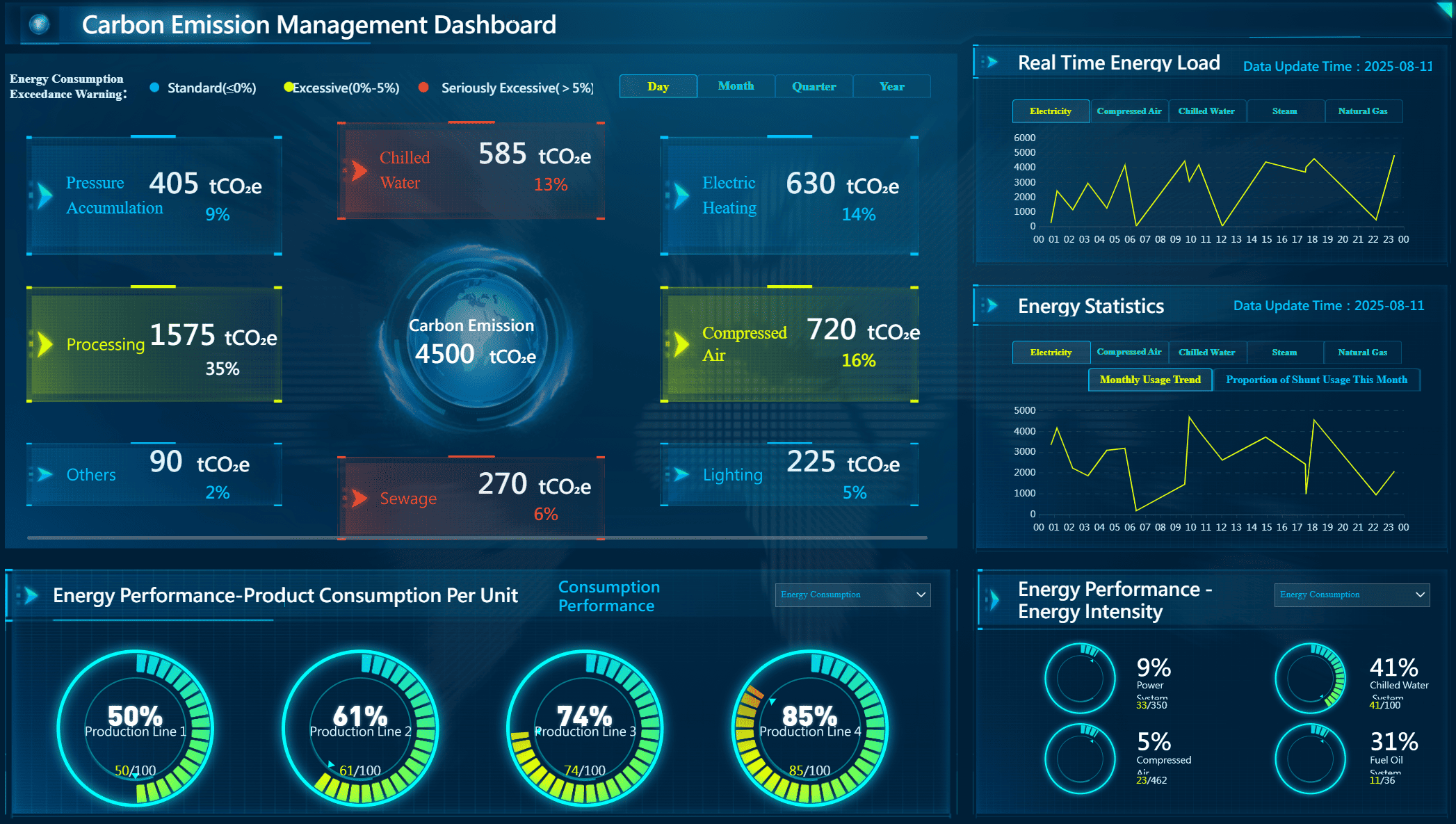
Key Components
An effective carbon management system includes several key components that enable businesses to manage emissions and drive sustainability:
- Carbon Footprint Calculation: Businesses measure total ghg emissions from energy, transportation, and supply chain activities.
- Data Collection and Analysis: Companies use emission management solutions and specialized software to gather and analyze carbon data.
- Setting Carbon Reduction Goals: Organizations define measurable objectives, often aligned with recognized frameworks, to guide their climate change strategies.
- Carbon Emissions Reduction Strategies: Businesses implement solutions such as energy efficiency upgrades, renewable energy adoption, and supply chain collaboration.
- Carbon Offsetting: Companies use certified offsets for unavoidable emissions, ensuring their carbon management systems remain robust.
- Monitoring and Reporting: Businesses continuously monitor emissions and report progress using standards like the Carbon Disclosure Project.
- Stakeholder Engagement: Organizations engage employees and external partners to build support for carbon management initiatives.
Digital solutions like FanRuan and FineReport play a vital role in emission management solutions. These platforms help businesses collect real-time carbon data, automate reporting, and visualize progress toward sustainability goals. FineReport enables companies to integrate data from multiple sources, track carbon footprint metrics, and manage carbon management systems efficiently. By leveraging these solutions, businesses can accelerate their climate change response and improve their overall carbon management framework.
Below is a Power Management Dashboard.
Strategic Advantages of Carbon Management
Cost and Efficiency
Companies that adopt carbon management strategies often see significant cost savings and operational improvements. By tracking carbon emissions and identifying high-impact areas, businesses can reduce energy consumption, cut waste, and streamline processes. Many organizations use emission management solutions to monitor real-time data and spot inefficiencies quickly. For example, FineReport enables businesses to collect and analyze carbon data from multiple sources, helping them find opportunities for reduction and cost control.
A clear carbon management strategy allows companies to:
- Lower utility bills by improving energy efficiency.
- Reduce material waste through better resource planning.
- Avoid unnecessary expenses by identifying and eliminating carbon-intensive activities.
- Access financial incentives, such as grants and tax credits, that support sustainable business practices.
Companies measure the return on investment from carbon management by setting clear objectives, tracking key performance indicators like energy savings, and calculating both direct and indirect financial benefits. They also consider intangible gains, such as improved brand reputation and employee engagement.
Compliance and Risk
Regulatory requirements for carbon emissions reporting have expanded rapidly across the globe. Businesses must now comply with a range of standards that demand transparency and accountability. Failure to meet these regulations can result in fines, penalties, and reputational damage. Proactive carbon management helps companies stay ahead of these changes and avoid costly surprises.
| Regulatory Framework / Standard | Region / Scope | Key Requirements |
|---|---|---|
| EU Corporate Sustainability Reporting Directive (CSRD) | European Union | Mandatory emissions disclosure including scope 1, 2, and 3 for large enterprises starting 2024 |
| UK Streamlined Energy and Carbon Reporting (SECR) | United Kingdom | Annual reporting of energy use and carbon emissions for large enterprises and LLPs |
| US SEC Climate Disclosure Rule | United States | Requires public companies to disclose material climate-related risks and scope 1 and 2 GHG emissions |
| California SB 253 & SB 261 | California, USA | Scope 1, 2, and 3 emissions disclosure and climate risk reporting for large entities |
| IFRS S1 and S2 (ISSB Standards) | Global | Mandated sustainability disclosures, including GHG emissions and climate-related financial risks |
Many countries, including Turkey, Nigeria, and Brazil, have adopted the IFRS S2 standard, requiring companies to disclose scope 1, 2, and 3 emissions. Other regions, such as New Zealand and Singapore, plan to make these disclosures mandatory soon. This global trend shows that businesses must integrate emission management solutions to keep up with evolving regulations.
FineReport supports compliance by automating carbon data collection, generating audit-ready reports, and ensuring that businesses meet the latest regulatory standards. With FineReport, companies can:
- Track carbon footprint data across all operations.
- Generate detailed reports for regulators and stakeholders.
- Adapt quickly to new compliance requirements.
- Integrate carbon data into risk assessments to anticipate financial and operational risks.
Carbon management transforms compliance from a reactive duty into a strategic advantage. By embedding emission management solutions into daily operations, companies can reduce the risk of non-compliance, build stakeholder trust, and support climate action.
Brand and Market Opportunities
Effective carbon management opens new business opportunities and strengthens brand reputation. As more consumers and investors demand sustainable products and services, companies that lead in carbon reduction gain a competitive edge. Businesses that decarbonise their operations and adopt low-carbon solutions attract eco-conscious customers and partners.
- Leading companies like Schneider Electric and IBM use advanced emission management solutions to position themselves as leaders in the low-carbon transition.
- IT and telecom firms develop green infrastructure and offer new services, such as solar energy packages, to reach sustainability-focused customer segments.
- Retailers invest in supply chain sustainability and product-level carbon transparency to meet consumer expectations.
Consumer preferences play a major role in driving change. Gen Z and Millennials, in particular, prioritize sustainability and often pay premiums for eco-friendly products. Companies that fail to demonstrate environmental responsibility risk losing market share. On the other hand, those that embrace carbon management can:
- Tap into emerging markets that value sustainability.
- Access new revenue streams through green products and services.
- Enhance brand loyalty and attract top talent.
- Meet the requirements of government programs and financial incentives that reward sustainable business practices.
The global shift toward net zero and climate change mitigation creates a dynamic environment for innovation. Early adopters of carbon management solutions stand to benefit from new business opportunity, increased market share, and long-term growth.
Below is a Green energy production dashboard.
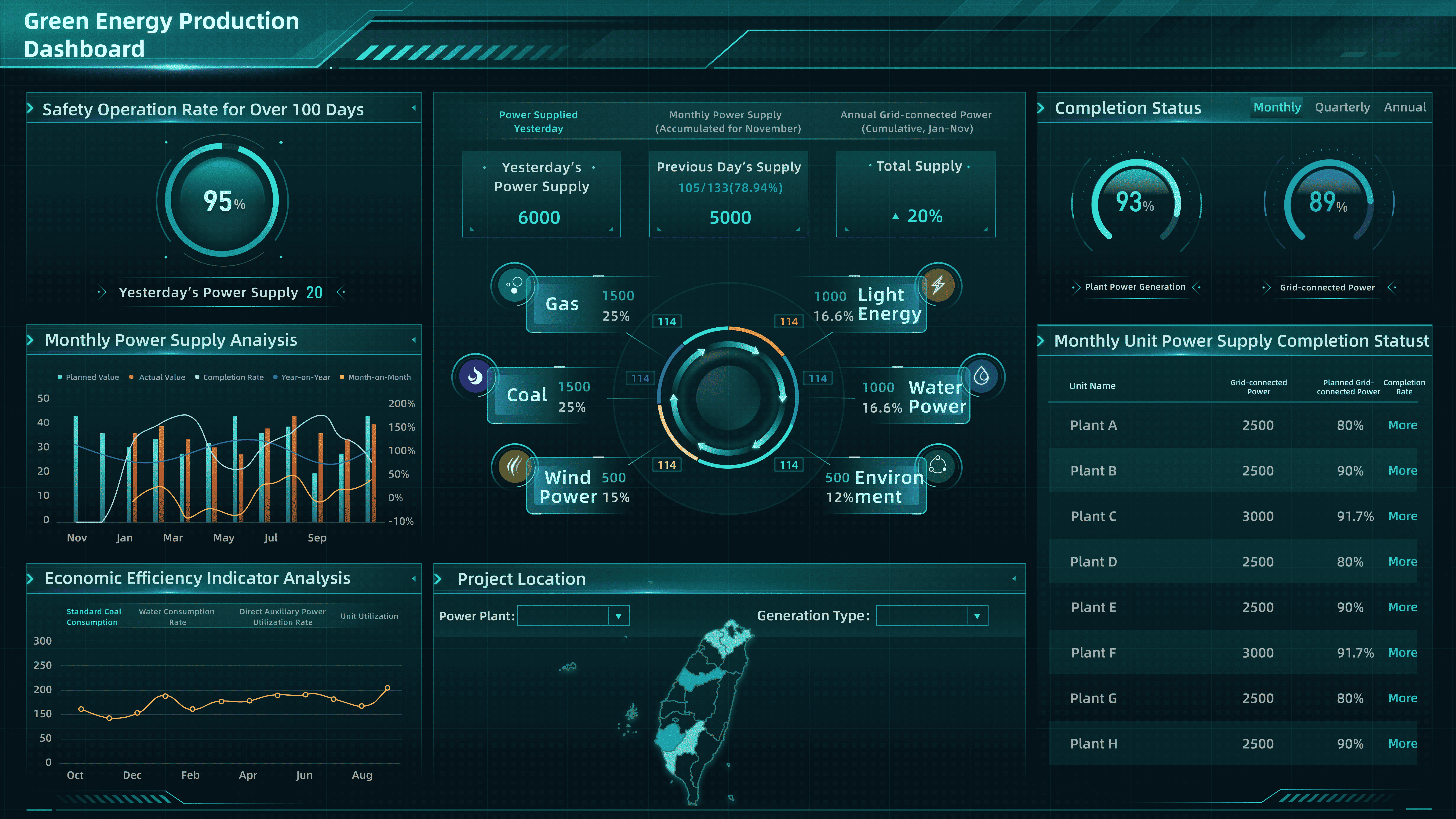
Implementing Carbon Management Strategy
Measuring Carbon Emissions
Businesses start a carbon management plan by measuring carbon emissions across their operations. Several methods exist for this process. The spend-based method uses financial records to estimate emissions. The activity-based method relies on physical data, such as fuel or material use, for more accurate results. Supplier-specific methods collect emissions data directly from suppliers, which increases accuracy but requires more resources. Some companies use industry averages for a quick assessment. Many organizations combine these approaches in a hybrid method, which balances accuracy and practicality. Accurate measurement helps companies understand their carbon footprint and supports effective solutions for reduction.
Setting Goals
After measuring emissions, companies set clear decarbonisation goals. Industry standards like the Greenhouse Gas Protocol and Science Based Targets initiative guide this process. Businesses often use benchmarks that fit their sector and operations. They involve stakeholders, including employees and suppliers, to make sure goals are realistic and impactful. Companies also use reporting frameworks, such as the Carbon Disclosure Project, to track progress and stay transparent. Setting science-based targets helps organizations decarbonise and move toward net zero, which improves their market position and supports climate action.
Identifying Carbon Reduction Opportunities
Companies identify carbon reduction opportunities by analyzing emissions data and using specialized solutions. Tools like the Greenhouse Gas Protocol, life cycle assessments, and environmental management systems help pinpoint major emission sources. Businesses often focus on energy efficiency measures, such as upgrading lighting or improving building insulation. Many switch to renewable energy or work with suppliers to reduce Scope 3 emissions. For example, some companies require suppliers to use renewable power or optimize logistics to cut fuel use. These strategies support the low-carbon transition and help organizations reach their reduction targets.
| Strategy Type | Description | Example / Initiative |
|---|---|---|
| Substitution | Replace high-carbon materials or energy with lower-carbon alternatives | Switch to renewable energy, electrify vehicle fleets, engage suppliers |
| Efficiency Improvements | Use fewer resources to achieve the same results, reducing waste and energy | Optimize routes, upgrade insulation, improve packaging, extend product lifecycles |
Leveraging Digital Tools
Digital solutions play a key role in carbon management. Platforms like FanRuan and FineReport help companies integrate data from many sources and monitor carbon emissions in real time. These solutions automate reporting, making it easier to meet compliance requirements and track progress toward decarbonisation goals. FineReport enables businesses to visualize carbon data, identify trends, and share insights across teams. Real-time data integration supports quick decision-making and helps companies adjust their carbon management plan as needed. By using advanced solutions, organizations can decarbonise faster and achieve their net zero targets.
Tip: Employee training and engagement are essential for successful carbon management. Companies should educate staff about carbon footprint concepts and encourage participation in sustainability initiatives.
Real-World Opportunities of Carbon Management

Industry Examples
Many companies now use carbon management to drive business growth and innovation. Retailers like Tesco have reported £37 million in annual savings after improving energy efficiency and reducing emissions in stores and distribution centers. Nike has cut energy usage intensity by nearly 50 percent, showing that carbon reduction can deliver both environmental and financial benefits. Businesses also see time efficiency gains. For example, digital tools have reduced reporting time by a factor of 80, allowing teams to focus on strategic actions. Predictive maintenance powered by AI has lowered operational costs by up to 50 percent. These examples show that carbon management creates new opportunities for cost savings, risk management, and competitive advantage.
| Business Benefit Category | Measurable Outcome / Example | Description / Impact |
|---|---|---|
| Operational Cost Savings | Tesco: £37 million annual savings | Achieved through energy efficiency improvements and emissions reduction (41% reduction in stores/distribution centers). |
| Energy Cost Savings | Up to 20% savings in energy costs | Resulting from identifying emissions hotspots and improving resource efficiency. |
| Emissions Reduction | Tesco: 41% reduction; Nike: ~50% reduction in energy usage intensity | Demonstrates direct environmental impact alongside cost savings. |
| Time Efficiency Gains | Reporting time reduced by factor of 80 (Plan A example) | AI and digital tools drastically reduce time spent on data collection and reporting, freeing resources for strategic action. |
| Maintenance Cost Reduction | 20-50% reduction via AI-driven predictive maintenance | Predictive analytics optimize maintenance schedules, reducing downtime and operational expenses. |
| Risk Management and Compliance | Enhanced regulatory compliance and proactive risk mitigation | Digital solutions enable real-time monitoring and better alignment with evolving climate regulations. |
| Competitive Advantage | Early adoption of decarbonisation strategies positions companies ahead of regulations | Builds resilience and meets stakeholder expectations, improving market positioning. |
| Employee Engagement | Increased through streamlined data processes and actionable insights | Frees sustainability teams to focus on impactful initiatives rather than manual data handling. |
EHS and Manufacturing
Manufacturing companies face unique challenges in managing carbon emissions and ensuring compliance. Many have adopted digital EHS (Environmental, Health, and Safety) solutions to improve safety and sustainability. FanRuan’s EHS management system, powered by FineReport, helps manufacturers monitor employee health, track safety training, and manage environmental risks. The system supports real-time data collection and analysis, making it easier to identify hazards and report incidents. Companies use these tools to reduce accidents, comply with regulations, and create safer workplaces. In automotive and electronics plants, managers use FineReport to monitor emissions, optimize resource use, and support carbon reduction efforts. These digital solutions help manufacturers achieve operational efficiency and meet sustainability goals.
Digital Transformation
Digital transformation has accelerated the adoption and effectiveness of carbon management practices. Organizations that use digital technology improve resource utilization and enable transparent information flow. Real-time monitoring supports lean production and helps companies respond quickly to changes. Baosteel, a leading steel producer, uses a carbon management platform that integrates real-time data to monitor emissions. The company reduced carbon intensity per ton of steel from 2.16 to below 1.98. Digital transformation benefits manufacturing and other industries by enabling proactive interventions and supporting sustainability. AI-driven tools optimize energy grids, supply chains, and reporting processes. These advances make carbon management scalable and accessible to more businesses.
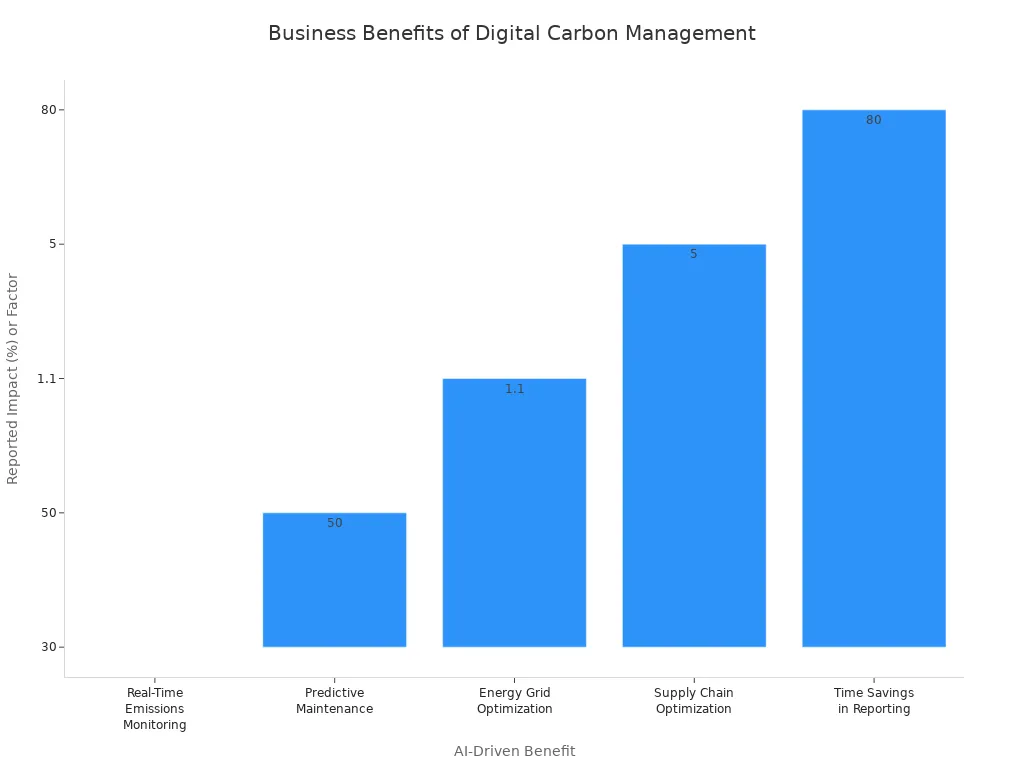
Tip: Companies that embrace digital transformation in carbon management gain opportunities for cost savings, emissions reduction, and improved compliance. These advances support long-term business growth and help organizations respond to climate change.
Companies that prioritize carbon strategies see measurable business gains. Many report cost savings, improved compliance, and stronger market positions.
77% of consumers say it’s at least moderately important that brands are sustainable and environmentally responsible.
- Enhanced brand value and market positioning
- Risk mitigation and regulatory advantages
- Revenue growth through innovation and B2B relationships
Digital tools like FineReport helps organizations track progress and stay ahead. Leaders who act now set their businesses up for long-term success.
Continue Reading about Carbon Management
How Data Management Consultants Boost Operational Efficiency
What is Product Data Management Software and How it Works
FAQ

The Author
Lewis
Senior Data Analyst at FanRuan
Related Articles
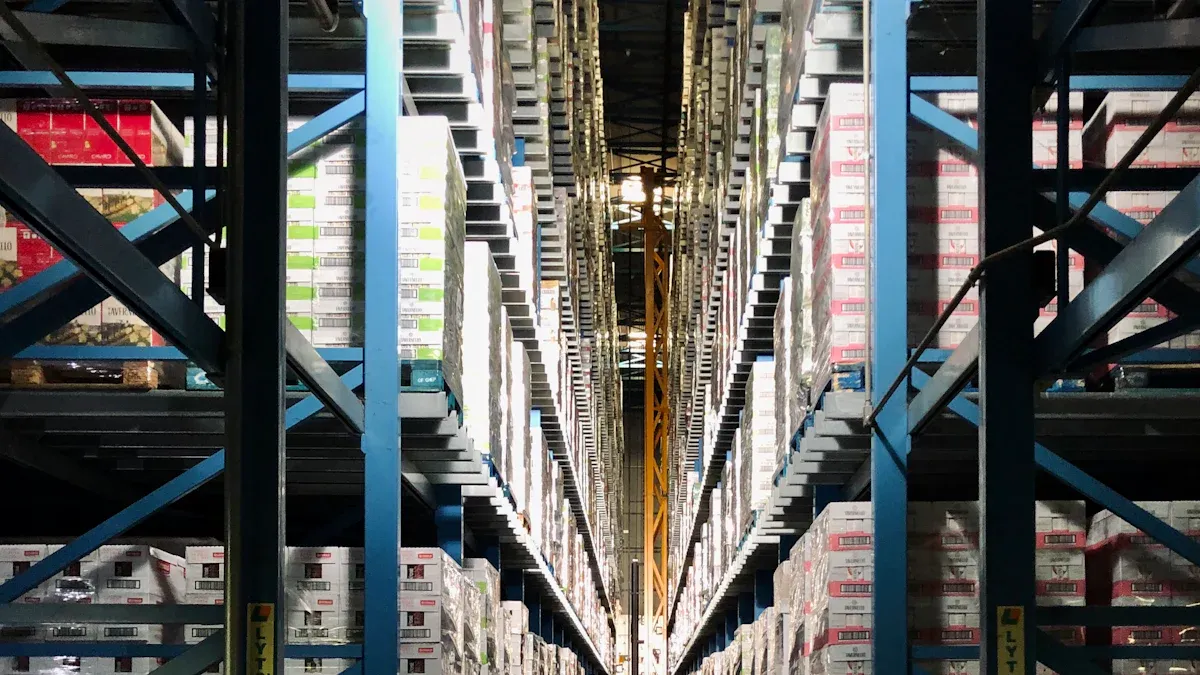
9 Best Supply Chain Tools for Smarter Management in 2026
Find the best supply chain tools for 2025 to boost efficiency, gain real-time insights, and achieve smarter management for your business.
Lewis
Dec 18, 2025
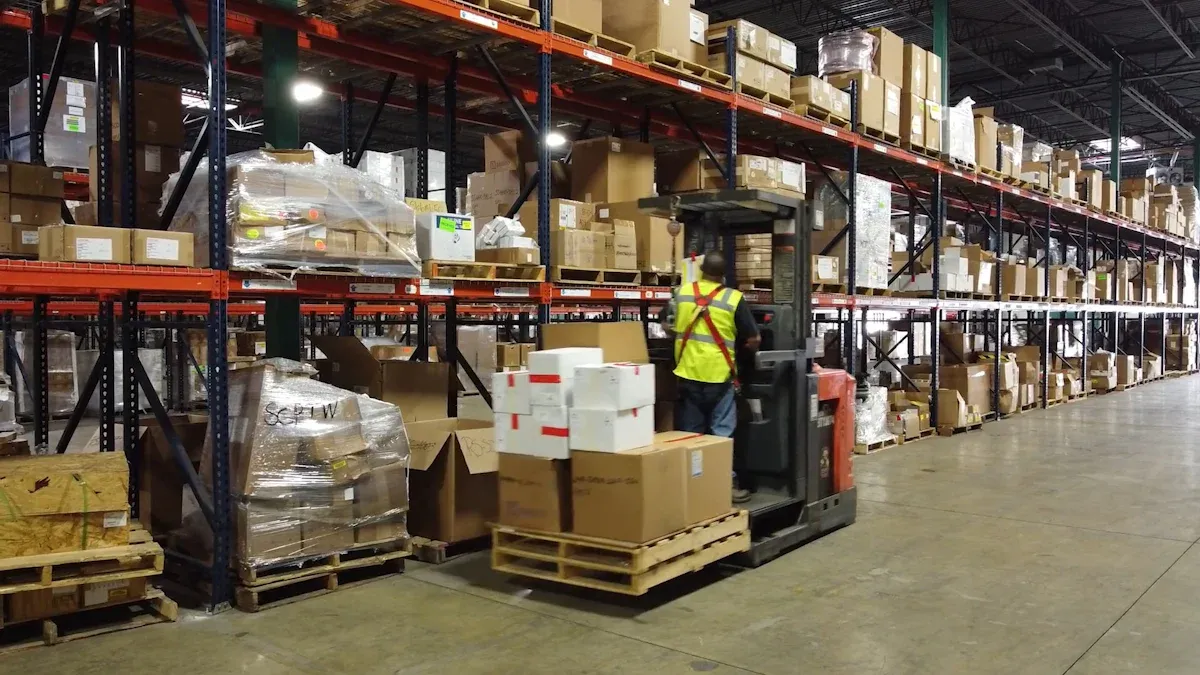
Top 10 Supply Chain Tracking Software for 2026
Compare the top supply chain tracking software for 2026 to boost visibility, automate workflows, and leverage AI analytics for smarter decisions.
Lewis
Dec 18, 2025

Top 10 Supply Chain Management Software for Small Businesses
See the top 10 supply chain management software comparison for small businesses in 2026. Compare features, pricing, and scalability to find your best fit.
Lewis
Dec 18, 2025




